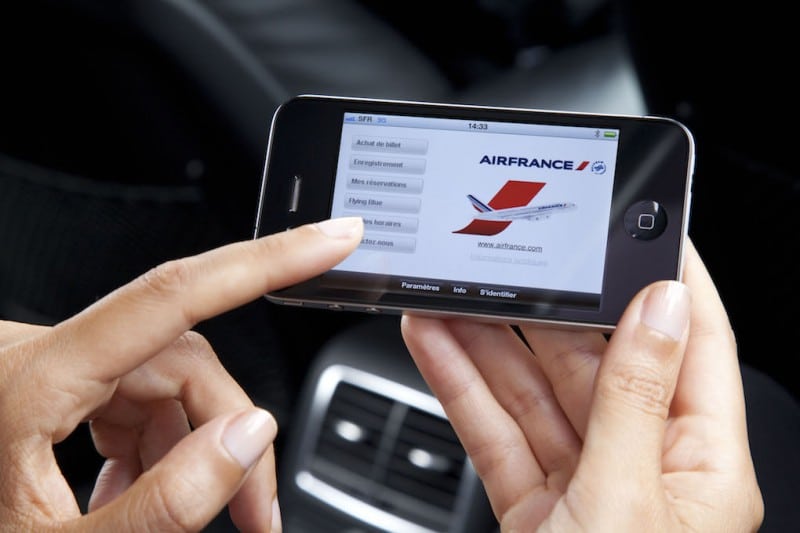[Avionics Today 12-05-2014] Air France has recently announced its intent to enter into a three-month In-Flight Connectivity (IFC) trial on short and medium haul routes through French telecommunications provider Orange — who has, in turn, chosen Global Eagle Entertainment (GEE) as its own technology and content partner. The airborne Wi-Fi trial, which will take place this in the summer of 2015 on two Airbus A320’s, will allow customers to browse the internet, read emails and watch live TV, among other activities, through their personal laptop, tablet or smartphone.
This new partnership announcement follows an ongoing trial with In-flight Wi-Fi onboard Air France long haul flights provided by Panasonic Avionics, which began in 2013 on Air France’s Boeing 777 aircraft. The incentive to deliver Internet access on both long and short haul flights is becoming more apparent, as passengers look to stay in the loop for both business and personal reasons throughout all phases of flight. And this need for connectivity isn’t looking to let up.
 |
| Air France will trial Wi-Fi on board short and medium haul fleets. Photo: Air France |
“It’s not a matter of if the airlines will go for connectivity or not, but when. We are convinced that in the close future, connectivity will be part of the services that airlines have to propose to their customers,” Pierre-Alexandre Calonne, IFC innovation manager at Air France told Avionics Magazine. “We see that people want more and more connectivity and are a bit impatient to deploy the system on the rest of the fleet,” he said, speaking to the long haul trial offering Air France is still running.
The problem with deploying fleet-wide connectivity, however, is that the solution is not as affordable as many airlines would like.
“Even on the mature markets, like in the U.S., the take rates currently are quite low so the business case is really difficult to achieve,” said Calonne, who pointed to the responsibility of providers to come up with lower price-points on connectivity solutions.
While the technology still has some ways to go as far as affordability, the tech itself has come a long way, which, along with the desire to please passengers, is encouraging airlines to equip. “It’s still a very expensive service to operate for the airlines, but it’s true that now we have more choice in terms of serious actors in the field. Now, we know also the technology is mature and coverage of the service has really soared during previous years so we are really confident that now it works, which is great.”
As the A320 does not include standard seat back In-Flight Entertainment (IFE) capability, the wide use of mobile devices by airline passengers makes connectivity equipage more affordable for airlines as they do not have to provide the devices that passengers will use to connect. But a more strategic, three-pronged partnership may be what really delivers cost benefits as far as the business case.
With Air France in charge of installing equipment, Orange overseeing the technical solution — from the supply of the satellite network to the portal accessible by passengers — and GEE’s role as the technology supplier, it’s possible the companies may choose to spread out the costs. What makes the arrangement particularly interesting is the role of wireless carrier Orange.
“It is unclear how the wireless carrier will participate and what it means for the industry,” said Andrew Spinola, vice president at Wells Fargo Securities. “If the wireless carrier acts as a sponsor that pays for the service and provides it as a free service to its own customers then that is a positive for the connectivity industry. However, if the wireless carrier will assume some part of the value chain then that makes the economics worse for everyone involved.”
While the particular economics of the situation are still unresolved, Calonne feels the value for Air France having Orange onboard is both real and measurable when it comes to providing and selling desirable content.
“We chose to team up with Orange to propose to Air France customers on short and medium haul fleet connectivity and entertainment. Those two aspects are exactly the core business of Orange, so we expect Orange to be able to offer to our customers a very competitive offer and a very high quality of service compared to what we could expect to provide on our own, without a telecom provider,” he said. “On top of this, Orange is also a strong brand and we know from customer surveys that there is a clear added value of the association of the two brands for the customers, which increases the willingness of the customer to buy the service if the service is co-branded.”
The engagement of Orange in the process garners trust for both passengers and airline alike. Air France is happy to have an experienced partner in a complex undertaking while name recognition allows both companies to brand more efficiently and, essentially, sell more subscriptions to the Wi-Fi once it comes available. These questions of affordability, technology and content are exactly what the airline is looking to address in the summer 2015 trial so that when it rolls out in full-force, the business case can be solid.
“We have to be sure it is the content people want, even on shorter flights. That’s the biggest question. Even if we are convinced it will work we have to prove that the business case will float,” Calonne said. “It’s also a complex partnership with Orange so we have to make sure that it works before we move forward.”